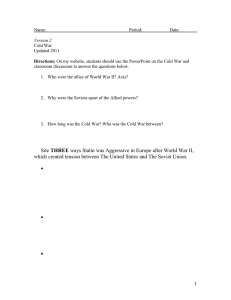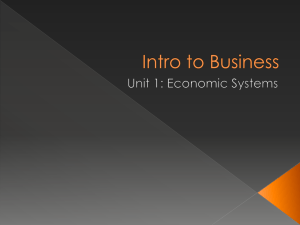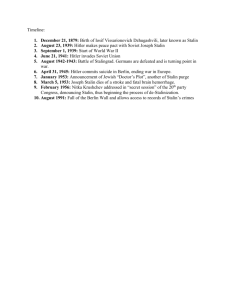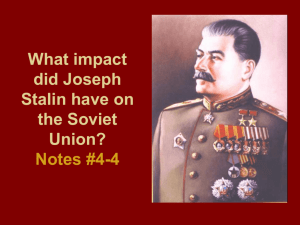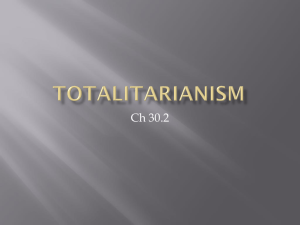DBQ 11: Evaluating Joseph Stalin Document-Based Assessment for Global History
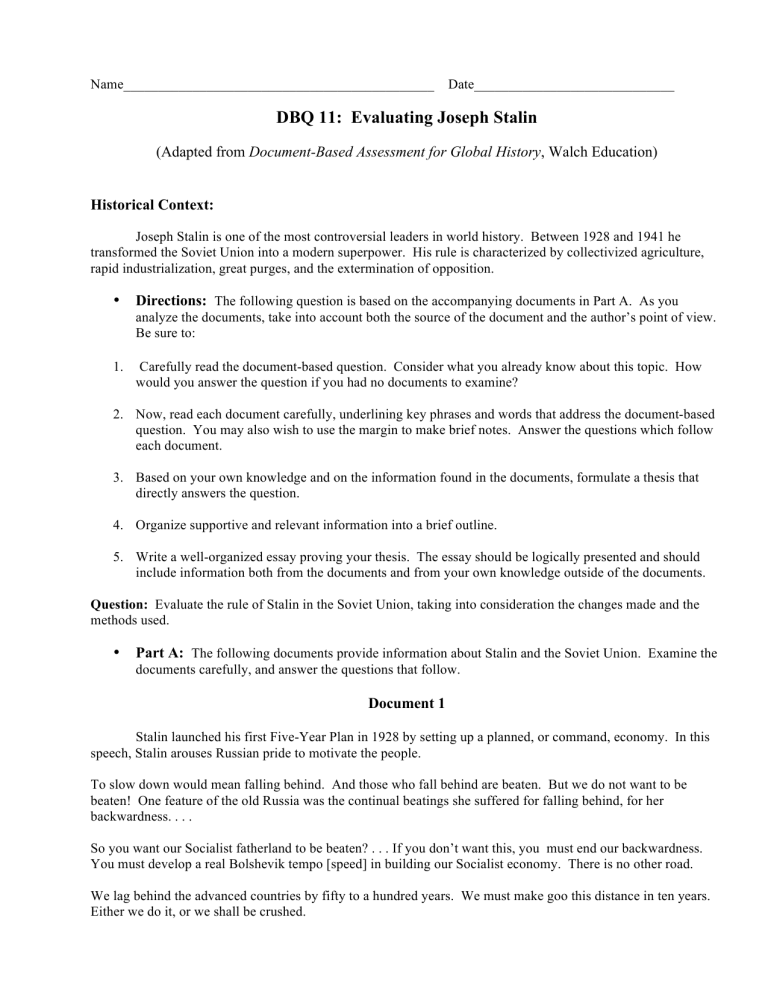
Name_____________________________________________ Date_____________________________
DBQ 11: Evaluating Joseph Stalin
(Adapted from
Document-Based Assessment for Global History
, Walch Education)
Historical Context:
Joseph Stalin is one of the most controversial leaders in world history. Between 1928 and 1941 he transformed the Soviet Union into a modern superpower. His rule is characterized by collectivized agriculture, rapid industrialization, great purges, and the extermination of opposition.
•
Directions:
The following question is based on the accompanying documents in Part A. As you analyze the documents, take into account both the source of the document and the author’s point of view.
Be sure to:
1.
Carefully read the document-based question. Consider what you already know about this topic. How would you answer the question if you had no documents to examine?
2.
Now, read each document carefully, underlining key phrases and words that address the document-based question. You may also wish to use the margin to make brief notes. Answer the questions which follow each document.
3.
Based on your own knowledge and on the information found in the documents, formulate a thesis that directly answers the question.
4.
Organize supportive and relevant information into a brief outline.
5.
Write a well-organized essay proving your thesis. The essay should be logically presented and should include information both from the documents and from your own knowledge outside of the documents.
Question: Evaluate the rule of Stalin in the Soviet Union, taking into consideration the changes made and the methods used.
•
Part A:
The following documents provide information about Stalin and the Soviet Union. Examine the documents carefully, and answer the questions that follow.
Document 1
Stalin launched his first Five-Year Plan in 1928 by setting up a planned, or command, economy. In this speech, Stalin arouses Russian pride to motivate the people.
To slow down would mean falling behind. And those who fall behind are beaten. But we do not want to be beaten! One feature of the old Russia was the continual beatings she suffered for falling behind, for her backwardness. . . .
So you want our Socialist fatherland to be beaten? . . . If you don’t want this, you must end our backwardness.
You must develop a real Bolshevik tempo [speed] in building our Socialist economy. There is no other road.
We lag behind the advanced countries by fifty to a hundred years. We must make goo this distance in ten years.
Either we do it, or we shall be crushed.
106
Name________________________________________________ Date__________________________
DBQ 20: Stalin: Evaluation of His Leadership
(continued)
What is Stalin trying to do in his speech? What method is he using to accomplish his goal?
___________________________________________________________________________________________
___________________________________________________________________________________________
_________________________________________________________________________
Document 2
Industry
Electricity (milliard kWh)
1927 – 1928
5.05
Target for 1933
17.0
Coal (million tonnes)
Oil (million tonnes)
Pig-iron (million tonnes)
Steel (million Tonnes
35.4
11.7
3.3
4.0
68.0
19.0
8.0
8.3
What is the goal of this Five-Year Plan? For what specific areas were goals set?____________________
___________________________________________________________________________________________
___________________________________________________________________________________________
_________________________________________________________________________
Document 3
The following chart shows industrial production under the Five-Year Plans.
The Buildup of the Soviet Economy in Industry
M 150 e t r 120 i c
T o 90 n s
--
I 60 n m
I l 30 Coal Production l i o n 0 Steel Production s
__
1928 1933 1938
1 st Five-Year Plan 2 nd Five-Year Plan
What does the chart show about Soviet industrial production?___________________________________
_____________________________________________________________________________________
(continued)
107
Name_______________________________________________ Date____________________________
DBQ 20: Stalin: Evaluation of His Leadership (
continued)
Document 4
In this excerpt from a 1929 speech delivered by Stalin, he explains the collectivization policy and the need to eliminate the kulaks (wealthy farmers).
The solution lies in enlarging the agricultural units . . . and in changing the agricultural base of our national economy. . . .the Socialist way, which is to set up collective farms and state farms which leads to the joining together of the small peasant farms into large collective farms, technically and scientifically equipped, and to the squeezing out of the capitalist elements from agriculture. . . . Now we are able to carry on a determined offensive against the kulaks, to break their resistance, to eliminate them as a class and substitute for their output the output of the collective farms and state farms.
According to Stalin, why and how must agricultural production be increased?_______________________
___________________________________________________________________________________________
_______________________________________________________________________________
Why must the kulaks be eliminated?_______________________________________________________
____________________________________________________________________________________
Document 5
The following illustrations show agricultural production during the First and Second Five-Year Plans.
The Buildup of the Soviet Economy in Agriculture
A 35 n i Livestock
The Buildup of the Soviet Economy in Agriculture
M 50 e
t r 40 i m 30 a l s 25 c
T 30 o Wheat_
__
In m 20 i l l 15 i n s 20
__
In m i l 10 l i o n 10 s
_
1928 1933 1938
1 st
Five-Year Plan 2 nd
Five-Year Plan o n 1928 1933 1938 s
__ 1 st
Five-Year Plan 2 nd
Five-Year Plan
What do the charts show about livestock numbers and grain production?_________________________________
___________________________________________________________________________________________
___________________________________________________________________________________________
___________________________________________________________________________________________
(continued)
108
Name______________________________________________ Date__________________________________
DBQ 20: Stalin: Evaluation of His Leadership
(continued)
Document 6 was printed in The Wall Street Journal, on July 7, 1983.
This excerpt, from “Forced Famine in the Ukraine: A Holocaust the West Forgot” by Adrian Karatnycky,
Today, reliable academic estimates place the number of Ukrainian victims of starvation at 4.5 million to 7 million.
. . . The famine was in part the by-product of Stalin’s relentless drive to collectivize Soviet agriculture. The famine was a clear result of the fact that between 1931 and 1933, while harvests were precipitously declining,
Stalin’s commissars continued to . . . confiscate grain. Peasants were shot and deported as rich, landowning
“kulaks”. . . . While the drive to collectivize agriculture was a wide-ranging phenomenon common to the entire
U.S.S.R., only in the Ukraine did it assume a genocidal character. Indeed there can be no question that Stalin used the forced famine as part of a political strategy whose aim was to crush all vestiges of Ukrainian national sentiments.
According to this author, what were two explanations for the elimination of between 4.5 and 7 million Ukrainians between 1932 and 1933?_______________________________________________________________________
___________________________________________________________________________________________
___________________________________________________________________________________________
___________________________________________________________________________________________
Document 7
In contrast to prior documents, this excerpt from The Land of Soviets, published in the U.S.S.R., gives another perspective of the collectivization.
The radical step forward by the majority of the peasantry towards a collective way of life was taking place against the backdrop of a bitter struggle between Soviet power and the kulaks. The [kulaks] stooped to all possible means to wreck the collectivization campaign. The murdered collective farm activists and Party and government officials sent to the villages to help the peasants; they set fire to collective farm buildings; they poisoned the cattle and destroyed farm machinery. . . . The Soviets had the right to banish them from
their villages. . . . The exploiter class—the rural bourgeoisie—was finally abolished. . . .
In contrast, how does the Soviet author explain the actions taken against the kulaks?________________________
___________________________________________________________________________________________
___________________________________________________________________________________________
___________________________________________________________________________________________
(continued)
109
Name_________________________________________ Date___________________________________
DBQ 20: Stalin: Evaluation of His Leadership (
continued)
Document 8
This excerpt , from The Land of the Soviets, published in the U.S.S.R, describes the results of the Five-Year Plans.
The fulfillment of the first and second Five-Year Plans strengthened the Soviet Union’s economic position and turned it into a powerful industrial state. . . . In 1937 the industrial output of the USSR was
5.8 times larger than in 1913. The rate of industrial growth in the USSR considerably exceeded that of the capitalist countries. By 1937 the Soviet Union was the first country in Europe and the second in the world in the volume of industrial production. . . . Socialist industrialization was accompanied by the rapid growth of the working class, and made it possible to liquidate unemployment. In 1940 there were 9,971,000
industrial workers, which was nearly three times more than in 1928. The working class was also changing: its efficiency, technical and cultural levels were growing rapidly.
According to the Soviet author, what were the results of the Five-Year Plans?________________________
______________________________________________________________________________________
______________________________________________________________________________________
______________________________________________________________________________________
Document 9
In this excerpt, the French ambassador to the Soviet Union described the public trials that were part of the “great purges” of Stalin.
I personally attended the second and third Moscow trials, those of 1937 and 1938. . . . Pyatakov [another defendant] arose . . . confessed . . . to a number of crimes. Did these “confessions” carry any share of truth? It is possible that the accused were hostile to Stalin’s regime. . . . But the lessons they recited must
have been forced from them . . . it is more likely that the GPU [secret police] touched each at his weak point.
It is also probable that the accused gave in to some form of pressure. . . . Some would give in to save their families, others in the hope of saving their own lives.
According to the French ambassador, what happened at the trials?__________________________________
_______________________________________________________________________________________
_______________________________________________________________________________________
(continued)
110
Name________________________________________________ Date___________________________
DBQ 20: Stalin: Evaluation of His Leadership (
continued)
Document 10
A Soviet poster was used to glorify Stalin.
It read, “Long live the great Stalin!”
•
Part B—Essay
Evaluate the rule of Stalin in the Soviet Union, taking into consideration the changes made and the methods used.
111
Grading Key Teacher Guide Page
Document 1
In this speech, Stalin reminded the Soviets that they had been beaten in the past due to their “backwardness.” Now, they needed to build up their economy very rapidly—in 10 years— or they would be crushed again. This speech was one of the methods Stalin used to motivate
the Soviets to action.
Document 2
The first Five-Year Plan set up a command economy in which government planners set targets for industrial production and power supplies. The first column indicates what was actually produced in 1927-1928; the second column shows the goals the government wanted to achieve by
1933. In most cases, the target is twice as much or more for production in 1933, only five years hence. This would require great effort and sacrifice of consumer goods by the people and changes in the workplace as well as the workers. The method used by Stalin is state planning of a command economy and government control of the people’s lives.
Document 3
The chart shows a dramatic increase in coal production between 1928 and 1938. There was also an increase in steel production. As a result, heavy industrial production increased.
Document 4
In this speech, Stalin explained how and why agriculture must change in order to feed the growing number of industrial workers. Farms would be joined together into state and collective farms, which would be equipped with the needed technology. As a result, food production would increase. But there was no room in this plan for the individual, capitalistic farmers, the kulaks. They must be driven out. Their agricultural production would be replaced with that of the state and collective farms. Thus Stalin was using the power of speech to motivate support for his economic plan and for the elimination of the kulaks as a class.
Document 5
These illustrations show the decline in livestock production. This was partly due to the government’s policy against the kulaks. At the same time, wheat production generally increased.
Document 6
This author describes the famine that resulted as part of Stalin’s collectivization of agriculture. Government officials continued to confiscate the grain of kulaks or peasants who resisted collectivization even though harvests were declining. Furthermore, the author claims that this government policy and the resulting “forced famine” was a genocide in the Ukraine. It was a political strategy used by Stalin to “crush all vestiges of Ukrainian national sentiments.”
It is a holocaust the West forgot, according to Karatnycky.
Document 7
This account from a Soviet perspective defends the actions taken by the Soviets against the kulaks. According to this Soviet account, the kulaks did everything they could to wreck the collectivization plan. They murdered government officials; they destroyed animals and farm machinery. Consequently, the Soviets had the right to abolish the kulaks.
Document 8
This account from a Soviet perspective applauds the positive results of the Five-Year Plans.
Industrial production was 5.8 times greater in 1937 than it was in 1913. In addition, unemployment was eliminated and the working class was more efficient and technically advanced. The Five- Year
Plans turned the U.S.S.R. into a powerful industrial nation.
112
Teacher Guide Page
Document 9
This account describes the “great purges” that Stalin used to eliminate anyone he thought opposed him. These people confessed for a variety of reasons. This is a method used in totalitarian states to eliminate opposition.
Document 10
Posters and pictures were used by Stalin for his personal advancement. Her attached himself to Lenin, the father of communism in Russia. In addition, he developed a cult of personality so that the Russians loved him as their father.
Additional Information Beyond the Documents
The documents provide students with only fragments of evidence. Answers should include relevant information from beyond the documents—information that students have learned from their classroom study. The following list suggests some of the information that students might include in their essays from outside learning.
Totalitarian government and their methods
Stalin and his practices in the U.S.S.R.
Conditions within Russia at the time.
Changes made under Stalin.
113
Sample Student Essay and Suggested Grading Teacher Guide Page
Throughout history, people have pondered the role of Joseph Stalin, one of the most controversial leaders in world history. However, his rule can easily be proved both positive and negative for the country of Russia. Positively he made Russia into a military superpower. But his methods had a negative impact on Russia.
Among Stalin’s accomplishments to the building of Russia, many were indeed positive.
Stalin introduced a five-year economic plan, which gave a number of quotas for both industry and agriculture. “The fulfillment of the first and second Five-Year Plans strengthened the U.S.S.R.’s economic position . . .” (Document 9) As shown by charts illustrating both industrial and agricultural growth (Document s 2, 3, 6), Stalin’s economic venues helped Russia to become a modern industrial society and let to Russia’s rise to a world power. Also the focus on heavy industry made to help increase the grandeur of the state. Under a command economy, in which the government controls all decisions made concerning the economy and personal lives, Russia with no doubt grew strong. Stalin said “To slow down would mean falling behind. And those who fall behind are beaten. But we do not want to be beaten!” (Document 1) Attitudes such as these helped to rally the people of Russia, so that they came together as a united force. People came together to provide workers for the factories, and farmers on the collective farms. Stalin created a feeling of pride and nationalism that also helped this country grow strong.
Yet, for all of Stalin’s positive accomplishments, he also seemed quite the negative ruler,
First, Stalin developed a system of collective farming that combined once privately owned farms into large farms, operated by the government. This put an end to individual profits. New he stressed, everything for the state must come first, the individual is second. “The Socialist ways set up collective farms . . . technically and scientifically equipped.. . ., squeezing out of the capitalist elements from agriculture.” (Document 4) Not only did he undermine the people of Russia, but he tortured, executed, or exiled anyone who opposed him. Continuing with the collective farming situation, kulaks, rich farmers, disliked Stalin’s system and openly resisted. Stalin immediately determined the kulaks should be punished. The kulaks were deported to forced labor camps or to Siberia.
Stalin also used a forced famine in the Ukraine to torture, and control his people.” . . . in the Ukraine
the collective farming assumed a genocidal character. . . . no question that Stalin used the . . . famine as part of a political strategy . . .” (Document 7) In addition, in order to control his people,
Stalin used propaganda to manipulate the people and provide only positive views of his communist dictatorship. In posters Stalin put himself in the shadows of Lenin, so as to be compared to a great leader, telling everyone that his methods were best for Russia. Stalin went as far as to use false trials to create and instill fear in his people. One French ambassador observed these trials and questioned,
“Did these ‘confessions’ carry any share of the truth?” (Document 10) Stalin’s radical means from these trials to his “. . . banish[ment]” of any opposition, truly created a terror-filled and negative image of Stalin.
In conclusion, although it is true that Stalin did much to positively affect the economy of Russia, he did so by harsh, cruel, and unnecessary means. He ultimately sacrificed his people, unmercifully for the outcome of the state.
Teacher Comments
This essay addresses all aspects of the task. It described the changes made by Stalin, which made Russia into a superpower and industrial giant. It also described the methods used by Stalin.
It integrates outside information with information from the documents. The essay is well organized
and has a strong introduction and conclusion. Score: level 5.
114
